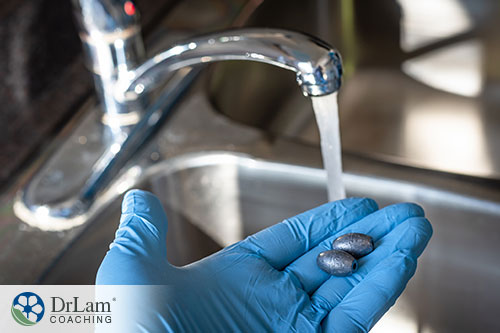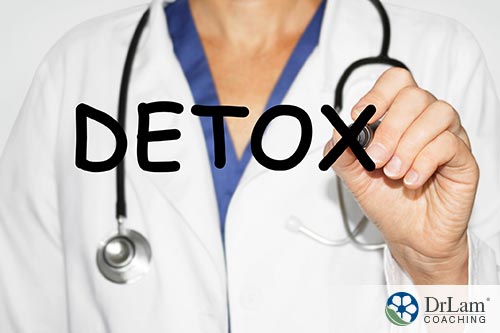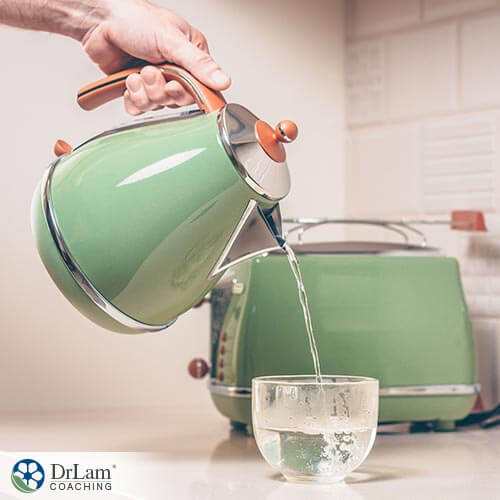 “Water, water everywhere, nor any drop to drink,” famously wrote the poet, Samuel Taylor Coleridge. The lines depicted a sailor of a becalmed ship surrounded by salty water that he cannot drink. On a similar note, have you ever thought about the safety of your tap water and whether you can drink it? Water is an indispensable component of your body. It hydrates, sustains, and maintains every living cell in your system. Therefore, it is imperative for you to have a working knowledge of what contaminates your tap water and the effect of tap water toxicity on your health.
“Water, water everywhere, nor any drop to drink,” famously wrote the poet, Samuel Taylor Coleridge. The lines depicted a sailor of a becalmed ship surrounded by salty water that he cannot drink. On a similar note, have you ever thought about the safety of your tap water and whether you can drink it? Water is an indispensable component of your body. It hydrates, sustains, and maintains every living cell in your system. Therefore, it is imperative for you to have a working knowledge of what contaminates your tap water and the effect of tap water toxicity on your health.
Tap water is usually regarded as safe to drink when it is supplied by a public water system, which is maintained by a municipality in an area. The tap water must comply with rigid safety standards when it is sent to consumers from a hydro facility. This generally means that the water still contains some contaminants, but the levels are far below the cut-off limit to cause any harm.
Tap water toxicity occurs when the water supply gets contaminated by chemicals from industrial waste, microorganisms from human or animal fecal matter, or fertilizers with drainage from farmland. Metals such as lead can leach into drinking water form worn-out lead pipes. Some of the contaminants of tap water include:
The Environmental Working Group (EWG) offers a free, simple-to-use database that provides the most detailed information on drinking water quality in the United States. EWG recognized tap water toxicity as a chief concern in the water supply of the United States since harmful chemicals, unwanted compounds, and heavy metals popped up during the testing of water.
For the analysis, the EWG used available recent data from 50,000 local utilities in every state and gave the report in 2019. The scientists compiled about 32 million tests for 517 different contaminants in tap water. These are some of their findings:
The researchers also pointed out that the Environmental Protection Agency (EPA) must update its enforceable health standards regarding the contaminants in drinking water.
Tap water toxicity has a deleterious effect on your health. The various contaminants impact your body in the following ways:
 Lead is toxic to nearly every major organ in the body. It gets absorbed in the bloodstream and has an effect on many parts of the body such as the kidneys, bone marrow, and brain. The toxicity is known as plumbism and is characterized by abdominal cramps, vomiting, lethargy, headache, seizures, and anemia. It is particularly risky for children since they are at higher risk for both absorbing and retaining the metal due to the size of their bodies. Even in small amounts, lead can be toxic, so you don't want any amount in your body.
Lead is toxic to nearly every major organ in the body. It gets absorbed in the bloodstream and has an effect on many parts of the body such as the kidneys, bone marrow, and brain. The toxicity is known as plumbism and is characterized by abdominal cramps, vomiting, lethargy, headache, seizures, and anemia. It is particularly risky for children since they are at higher risk for both absorbing and retaining the metal due to the size of their bodies. Even in small amounts, lead can be toxic, so you don't want any amount in your body.
Arsenic in tap water causes cancers of the urinary bladder, lung, and skin. Researchers performing studies in areas with lower levels of arsenic in tap water have reported positive or inconsistent outcomes.
Perfluoroalkyl and polyfluoroalkyl substances (PFAS) are chemicals found extensively everywhere and have made their way into the environment. They are a potent source of tap water toxicity. You are probably exposed to these chemicals by eating water or food contaminated with PFAS. You are also susceptible to contamination when you use products made with PFAS, or breathe air containing PFAS.
Researchers have shown likely links between human exposure to PFAS and negative health outcomes. The impact of PFAs on your health include adrenal fatigue, change in metabolism, change in detoxification, reproductive issues, decreased fetal growth, and increased risk of weight gain. They also lower the ability of the immune system to get rid of infections.
As per the International Agency for Research on Cancer (IARC), drinking water may be a primary source of nitrate exposure when concentrations above the cut-off limit are found. Diet is the primary exposure route below the threshold. Researchers have connected long-term exposure to nitrates in tap water with multiple cancer sites in the esophagus, stomach, bladder, and colon.
Other important chemicals causing tap water toxicity include atrazine and fluoride.
Atrazine is an extensively used weed killer and finds its way into drinking tap water. Researchers have demonstrated its role in interfering with the hormonal function of your body, causing adrenal fatigue.
Similarly, higher amounts of fluoride in tap water have resulted in issues with the nervous system and increased risk of diabetes and cancers.
Algae blooms can be a nuisance and may produce toxins. The researchers have shown that the liver is a target organ for microcystin, which are toxins produced by cyanobacteria (blue-green algae). This alters the metabolic and detoxification functions of the liver.
Contamination of tap water can occur in worn-out infrastructure. In such conditions, it becomes a breeding place for a number of microbes such as bacteria, viruses, fungi, and parasites. Researchers have revealed tap water to be a source of bacteria such as Shigella species and parasites such as Giardia, causing bloody diarrhea. The bacteria and parasites result in internal stress and cause further activation of your immune system. This precipitates imbalances of the Detoxification circuit.
 Tap water toxicity impacts your body by exposing it to toxins. Toxins act as external stressors that activate the NeuroEndoMetabolic(NEM) Stress Response. The NEM system is your body’s way of handling stress. There are six circuits of organs and systems involved in the NEM stress response that work in collaboration against stress.
Tap water toxicity impacts your body by exposing it to toxins. Toxins act as external stressors that activate the NeuroEndoMetabolic(NEM) Stress Response. The NEM system is your body’s way of handling stress. There are six circuits of organs and systems involved in the NEM stress response that work in collaboration against stress.
The main circuit that is impacted by tap water toxicity is the Detoxification circuit. It consists of the liver, the extracellular matrix (ECM), and the immune system. Together, they clear your body of excessive, unwanted, reactive metabolites that come from stress.
Under the conditions of acute stress posed by the consumption of harmful toxins in tap water, your body responds by rapidly increasing cortisol levels. This hormone acts as an anti-stress hormone and is released from the adrenal glands. However, the adrenals can produce less cortisol under conditions of prolonged, chronic stress due to fatigue. This leads to Adrenal Fatigue Syndrome (AFS). When the adrenals start to break down, it affects every organ and circuit in the body.
The detoxification circuit often becomes dysfunctional in the early stages of AFS, and this can become a vicious circle. Your body carries out the detoxification process of the toxins due to tap water toxicity in the liver. The liver converts them into water-soluble metabolites and inactivates them. However, when the toxins pile up on a chronic basis, the body does not have a built-in detoxification mechanism strong enough to do this work completely. The metabolites may not be removed properly or quickly enough and may remain active. Active metabolites are also called reactive metabolites because they react with other things in the body and can become toxic.
Eventually, liver damage occurs when the liver can no longer handle the toxins. Since the liver is put on overdrive, the body is flooded with more downstream metabolites, both inert and reactive. These lead to increased congestion in the surrounding extracellular matrix. As this condition worsens, sluggish liver develops which triggers inflammation and the immune system. The immune system stays active and continues to cause inflammation that actually starts to hurt the body rather than help it. This adds up to a toxic build-up in the interstitium, or the extracellular matrix, that the liver struggles to cope with and expel.
Further, this situation causes stress as well as potentially devastating physical symptoms. When this occurs, it will quickly impact your long-term health and quality of life. Subtle signs include an increase in food sensitivities, gastric bloating, and constipation. You may experience exaggerated responses to drugs and paradoxical reactions to medications. You can also develop problems such as insomnia, brain fog, and anxiety. There can be flare-ups of autoimmune conditions, heart palpitations, electrolyte imbalances, infections, and cancers. It is unfortunate that most of these symptoms are ignored and passed over as a normal part of the aging process until severe.
According to the Centers for disease control and prevention (CDC), you can decrease your risk of tap water toxicity by:
Here are some steps you can take if you are concerned about tap water toxicity:

If you have other health conditions and are concerned they could be due to tap water toxicity, please seek advice from a qualified healthcare practitioner who will assess your particular situation and advise you on additional ways to mitigate tap water toxicity and determine whether different detoxification methods are right for you.
If you would like to get more information about detoxification and the effects of tap water toxins, the team at Dr. Lam Coaching can help. We offer a free** no-obligation phone consultation at +1 (626) 571-1234 where we will privately discuss your symptoms and various options. You can also send us a question through our Ask The Doctor system by clicking here.
Tap water toxicity is caused by the contamination of tap water by chemicals from industrial waste, pharmaceuticals, farms, and microorganisms from human or animal fecal matter or fertilizers. Metals such as lead can leach into drinking water form worn-out lead pipes.
